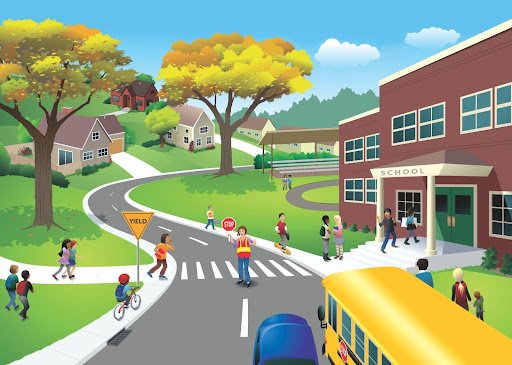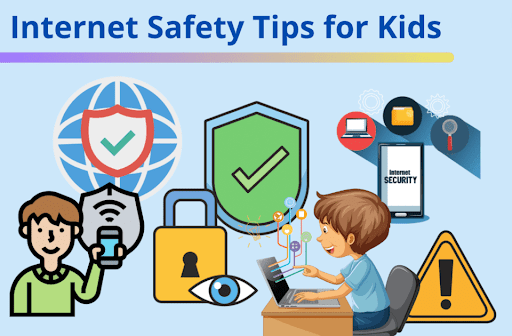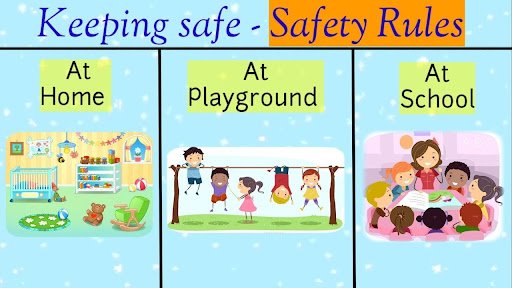Nowadays, take necessary child safety measures to ensure the safety of your little ones. Take carefulness is of the greatest importance, as it provides a protective umbrella during play and daily activities. Use child control methods in the home and secure them with utensils, outlets and sharp objects to create a safe environment. Stay informed about online safety, guide your child in responsible internet usage, and monitor their online communications. Make sure you know the emergency protocols, including first aid, so you can rapidly handle any unexpected cases. Keep schools and caretakers updated with your contact information, facilitating quick communication during troubles. These measures will safeguard your loved ones and encourage a supportive environment for their wellbeing. Don’t be afraid to share with your child and provide a secure and protected upbringing at every stage of their life.
Child Safety Measures: Protecting Your Loved Ones
In today’s world of ever-evolving technology and social mobility, prioritising child safety measures has become more important than ever. The welfare of our young members is important in our responsibilities, and we must admit and manage the potential risks they will face. This address introduction aims to establish the utmost importance of protecting our children from a rapidly changing environment.
Parents and caregivers play a crucial role in forming a shield that protects our loved ones. Their energetic involvement and participation are essential to creating an environment that fosters both physical and emotional safety. It’s not just about protecting children from physical harm but it’s also about navigating the complexities of the digital realm, where online threats are rife.
As we examine child protection policies, it is important to emphasise the active role of parents and guardians. Through wise decision-making and deliberate care, they become the master architects of a safe and nurturing environment in which children can thrive. This introduction sets the stage for an in-depth examination of many aspects of child protection, where collective community efforts protect and empower the next generation in an ever-evolving world.
Supervision and Vigilance
In the constant supervision, particularly for young children, holds critical importance in ensuring their safety and well-being. Child supervision and watchful parenting are essential to prevent accidents, injuries, and potential hazards. Young children, characterised by interest and lack of awareness about dangers, require sharp oversight to navigate their environment safely. This involves monitoring activities, surroundings, and relations to mitigate risks and respond promptly to unexpected circumstances. Adequate supervision enables a secure and nurturing environment, aiding in the development of a child’s cognitive and emotional well-being. It not only prevents accidents but also facilitates early detection of developmental issues or concerns. By emphasising constant supervision and watchful parenting, guardians contribute to a child’s healthy growth and create a foundation for lifelong safety habits and responsible behaviour.
Childproofing Your Home
Childproofing your home is important to ensure the safety of your little ones as they explore their surroundings. Begin by installing safety gates at stairways and entrances to restrict access to potentially dangerous areas. These gates are adjustable and easy to install, providing a physical barrier that keeps curious toddlers away from dangers.
Cabinet locks are critical to prevent children from accessing household cleaners, sharp objects, or medications. Choose locks that are secure yet easy for adults to operate. Place them on cabinets within a child’s reach, ensuring that potentially harmful items are out of sight and out of reach.
Outlet covers are required for electrical safety. They safeguard electrical outlets with child-resistant covers to prevent children from inserting objects and risking electric shock. Opt for an easy cover for adults to use while providing a strong barrier against curious fingers.
Childproofing tips include regularly inspecting your home for potential hazards, securing heavy furniture to prevent tipping, and keeping small objects out of reach. Prioritise home safety by considering the unique needs and behaviours of your child as they grow and explore. Implementing these childproofing measures creates a secure environment, allowing your child to explore and learn safely.
Road Safety for Kids
Ensuring road safety for kids is important. Teach children road rules early, emphasising the importance of looking both ways before crossing. Implementing child car seat guidelines is essential to secure infants in rear-facing seats and transition to forward-facing seats as they grow. Booster seats are essential until a child reaches the appropriate height. Regularly emphasise the significance of seat belts. Encourage walking on sidewalks and using crosswalks. Set a positive example by following traffic rules diligently. By sowing these habits early, we empower children to navigate roads safely and develop a lifelong commitment to road safety.

Stranger Danger and Online Safety
Teaching children about stranger danger and online safety is crucial in today’s digital age. Parents should notice traditional stranger danger tips, emphasising the importance of not talking to unknown individuals. Simultaneously, instilling internet safety for kids is important, teaching them to never share personal information online, avoid engaging with strangers on social media, and identify potential cyber threats. Hence, balancing real-world and virtual protection provides children with the tools to navigate both physical and online environments safely, promoting a secure and informed upbringing.

Fire Safety and Emergency Preparedness
The fire safety is important for protecting lives and property. A well-thought-out fire safety plan is essential for every household. Begin by establishing smoke detectors in key areas and regularly checking their functionality. They establish escape routes and ensure all family members are familiar with them. In the event of a fire, the stop-drop-roll technique is important, teaching individuals to stop moving, drop to the ground, and roll to smother flames if their clothing catches fire.
And emergency contact information must be easily accessible. Compile a list of emergency numbers, including local fire and police departments, and share it with family members. Fire safety tips include never leaving cooking soles, keeping explosive materials away from heat sources, and having fire extinguishers on hand. Families should also discuss and practice emergency preparedness, covering scenarios beyond fires. Let’s develop a communication plan, assemble emergency kits, and establish meeting points. These measures ensure that everyone is well-prepared in the face of unexpected events, promoting a safer and more resilient community.
First Aid Basics for Parents
The parents play an important role in ensuring the safety of their children, and having knowledge of basic first aid can be valuable in times of need. Child first aid contains basic skills to address common childhood injuries. For cuts and scrapes, clean the wound with mild soap and water, apply an antiseptic, and cover it with a sterile bandage. In cases of minor burns, cool the affected area with running water and protect it with a clean, non-stick dressing.
For potential fractures or sprains, immobilise the injured limb with a splint or bandage, and seek medical attention promptly. Familiarise yourself with the Heimlich scheme to address stopping incidents, especially in younger children who may be prone to putting small objects in their mouths. Additionally, understanding basic first aid for kids involves recognizing signs of allergic reactions and having access to an epinephrine auto-injector if needed.
Being proactive in child first aid involves creating a safe environment, staying informed on emergency contact information, and attending CPR courses. By incorporating these basic first aid practices into parenting, caregivers can confidently respond to common childhood injuries, ensuring the well-being of their little ones.
Safe Touch and Communication
Here are a few tips for ensuring children understand the concepts of safe and unsafe touching is paramount for their well-being. Teaching them about safe touch and communication is an important aspect of child safety education. Parents, guardians, and educators play key roles in imparting this knowledge to empower children to protect themselves.
Child safety communication is a key element in this process. Encouraging an open and non-judgmental dialogue allows children to express their feelings and concerns, fostering trust. It’s essential to teach boundaries, helping children identify personal space and understand what comprises appropriate or inappropriate touch.
Educators can use age-appropriate methods to convey these lessons, using scenarios and role-playing to enhance comprehension. Supporting the importance of communication empowers children to articulate their feelings, ensuring they feel heard and supported.
By incorporating safe touch education into early childhood development, society equips children with the tools to identify and report inappropriate behaviour. This proactive approach creates a foundation for a safe and respectful environment, instilling confidence and safeguarding children against potential harm. Through holistic child safety communication and the emphasis on teaching boundaries, we contribute to fostering a culture that prioritizes the well-being and protection of our youth.
Creating Safe Spaces
Creating safe and open environments at home holds immense significance in fostering healthy development and well-being for individuals, especially children. A child-friendly home serves as the foundation for emotional, social, and cognitive growth. When children feel secure in their surroundings, they are more likely to explore and learn, building a solid foundation for future endeavours.
Safe spaces for kids within the home contribute to emotional stability. These designated areas offer a haven where children can express themselves freely, fostering emotional intelligence and communication skills. A child-friendly home not only physically safeguards youngsters but also nurtures their mental and emotional health, providing a supportive atmosphere for self-expression.
Moreover, a secure home environment promotes trust and open communication between parents and children. It encourages children to share their thoughts and concerns without fear of judgment, facilitating positive parent-child relationships. This, in turn, aids in the development of strong interpersonal skills and a sense of belonging.
In essence, fostering safe and open environments at home, with a focus on creating child-friendly spaces, is paramount for nurturing well-rounded individuals. Such environments lay the groundwork for a positive and resilient mindset, influencing a child’s overall development and shaping their future interactions with the world.

Conclusion
Child safety is important, and implementing key measures plays a crucial role in safeguarding children. Firstly, constant supervision is essential, especially for younger children, to prevent accidents and ensure a quick response to any emergencies. Creating a safe physical environment involves childproofing homes, securing hazardous items, and installing safety gates. Educating children about potential dangers and teaching them age-appropriate safety skills empowers them to make informed choices.
Establishing open communication with children encourages them to share their experiences and concerns, fostering a supportive and protective environment. Additionally, promoting awareness about online safety is vital in today’s digital age, emphasizing responsible internet use and monitoring online activities. Regular health check-ups and vaccinations contribute to overall well-being and protection against preventable diseases.
Parents and caregivers should prioritize creating a safety plan that includes emergency contacts, evacuation procedures, and first aid knowledge. Encouraging community involvement and staying informed about local resources, such as child protection services, strengthens the safety network. In conclusion, a comprehensive approach to child safety involves a combination of supervision, education, communication, and preventive measures to ensure the well-being of children. Parents and caregivers must actively prioritise these measures to create a secure environment and empower children to thrive safely.
For more enriching educational resources and insights, delve further into Chrysalis High.
FAQs
What are the primary child safety measures at home?
Should secure furniture and appliances to prevent tipping and falling dangers and keep dangerous substances, sharp objects, and small items out of the child.
How can I teach my child about online safety?
Should educate your child on the importance of not sharing personal information online and stop interacting with strangers.
How can I explain stranger danger to my child without scaring them?
Use simple language to explain that not everyone is a friend, and encourage open communication about any uncomfortable feelings or situations.
What are the basics of child first aid that every parent should know?
Learn CPR and basic first aid for choking to respond quickly in emergencies. Be aware of common childhood injuries, know how to clean and dress wounds, and have essential medical information readily available.


